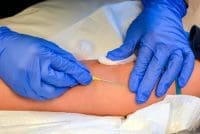Single parents face many challenges when accessing healthcare for their children and themselves, and have health issues that may go unrecognized, particularly for single fathers. The number of single father households has increased dramatically over the past few decades. There were fewer than 300,000 single father households in 1960, but in 2011 that number increased to more than 2.6 million—a 8.6-fold increase from baseline. Despite this jump in numbers, the literature addressing health-related issues of single fathers is rather scant. In this blog, we disseminate the limited number of studies on the subject and make recommendations for nurses to address the health disparities for this unique segment of population.
Lack of recognition
Life in a single-father household can be a challenge for both children and the single parent. While it’s well recognized that single women with children face disparities and inequities in health, healthcare access, and care due to gender and socioeconomic factors, single fathers face the same concerns and also struggle because their unique vulnerabilities often go unrecognized by healthcare providers. Health disparities in men include access barriers to primary care, gender influenced help-seeking, and disproportional rates of suicide and environmental violence. In addition, mortality rates in men may be closely related to the race and social status.
Here is a closer look at disparities related to healthcare access and health status.
Healthcare access
Barriers faced by single fathers raising children who are trying to maintain health and access to health services are not well represented in the literature. Poverty and poor health are almost synonymous and 19.1 % of single fathers live below the poverty level, compared with 8.4% of married couples. Single fathers face inadequate economic and social resources, resulting in inadequate health insurance coverage and overall poorer health. Historically, the income and education levels of married fathers continued to increase over time, whereas single fathers remain at educational and economic disadvantage.
Men who have more difficulty accessing primary care experience poorer health outcomes. Young men of all ethnicities and races disproportionately face early death, a public health crisis that is currently unrecognized. It’s important to acknowledge the persistence of these barriers and use targeted strategies at the national, community, and healthcare provider levels. These strategies may include more targeted men-centric prevention services, provider communication, better integration of interprofessional services, more government funding for services, education, and training, and more outreach.
Health status
Poverty is associated with poorer perceived health status. Single fathers report lower levels of self-perceived health, experience more economic and social disadvantage, and have higher unemployment when compared to partnered fathers. In addition, single fathers self-rate their mental health at a lower level than partnered fathers.
Single fathers may face additional challenges compared to their married counterparts. A single parent has fewer opportunities to socialize which may lead to feelings of distress and depression. Furthermore, men are more prone to the depressive effects of separation than women. When a father assumes the role of sole custodian, he takes on the responsibility of childcare as well as additional responsibilities of household maintenance, roles that are not routinely enculturated in men. Enculturated roles suggest that men avoid help-seeking leading to a less use of preventative services and delay in seeking healthcare when needed.
Men in general have higher levels of mortality and lower levels of morbidity compared to women. It has been hypothesized that this difference in mortality rates may be related to the differences in help seeking behaviors. Cultural gender roles may represent a barrier to health screenings in men. Avoidance of help seeking may be related to enculturated gender stereotypes, and may lead to a lower frequency of preventative healthcare and a delay in seeking healthcare when needed. Another reason for high mortality may be that men may not recognize disease symptoms that warrant seeking help from a healthcare provider.
Single father status may also affect life expectation and mortality rate. When compared to single mothers, partnered fathers, or partnered mothers, single fathers have higher mortality rates. In addition, single fathers may present with increased risks for injury or addiction, which in turn may result in higher mortality.
Implications for nurses
Men in single parent households have unique health disparities compared to men living in two-parent households. A combination of lower income levels, vulnerability to mental and physical illness, and reduced health seeking behavior may lead to poorer health outcomes. Nurses can help combat these health disparities by recognizing the unique health challenges single fathers face.
- Nurses can be instrumental in identifying single fathers and addressing their healthcare needs. For example, school nurses may identify single father families and direct single fathers to the available health services in the community.
- Nurses could learn more about men’s health to develop better understanding of health challenges single fathers may face. Cultural competence and family assessments are a basic nursing skill. Using these skills to identify single father’s needs and recognize pervasive gender stereotypes may help alleviate the unique barriers to healthcare that single fathers encounter.
- Community-based nurses could actively seek contact with single fathers in the workplace, recreational events, or places of worship to conduct assessments and referrals.
- Nurses in the inpatient setting could identify single fathers and refer them to available social services and support groups upon discharge, which may result in better health outcomes.
- Since single fathers rate their mental health at lower level compared to other parental groups, nurses and other healthcare providers could use mental health screening, which may result in better mental health outcomes for this group.
- Advanced practice nurses (APNs) have an increasingly important role in providing high quality and affordable healthcare services in primary care setting. APNs could offer more services that focus on preventative men’s health. Wider availability of these services in primary care and other clinics/healthcare settings may result in better health outcomes for single fathers.
Nurses can lead the way
The health of single fathers is a multifactorial issue that is affected by traditional views of gender roles, masculinity stereotypes, health seeking behaviors, and social structures. Since nurses have always been on the forefront of identifying and addressing unmet healthcare needs, this is another opportunity for them to lead the way. While the number of single father households has been steadily growing, the issues faced by this group have not been sufficiently researched. Ultimately, further research efforts are needed to explore the topic of health in single fathers, so nurse researchers should continue to seek the avenues for funding to explore this important topic. Generating new knowledge may help healthcare providers at all levels recognize the challenges single fathers may face and take steps to address healthcare disparities associated with single fathers.

All three authors work at East Tennessee State University College of Nursing in Johnson City, Tennessee. Alex Sargsyan is an assistant professor, Jean Hemphill is academic director for the DNP program and an associate professor, and Lee Ridner is a professor.
Selected references
Addis ME, Mahalik JR. Men, masculinity, and the contexts of help seeking. Am Psychol. 2003;58(1):5-14.
Banks I, Baker P. Men and primary care: improving access and outcomes. Trends Urol Men’s Health. 2013;4(5):39-41.
Brown BV. The single-father family.Marriage Fam Rev. 2000;29(2-3):203-220.
Case A, Paxson C. Sex differences in morbidity and mortality. Demography. 2005;42(2):189-214.
Chiu M, Rahman F, Kurdyak P, et al. Self-rated health and mental health of lone fathers compared with lone mothers and partnered fathers: a population-based cross-sectional study. J Epidemiol Community Health. 2016;71(5):417-423.
Chiu M, Rahman F, Vigod S, et al. Mortality in single fathers compared with single mothers and partnered parents: a population-based cohort study. Lancet Public Health. 2018;3(3):e115-e123.
Cox B, Sneyd MJ. School milk and risk of colorectal cancer: a national case-control study. Am J Epidemiol. 2011;173(4):394-403.
Flint J, Kendler KS. The genetics of major depression. Neuron. 2014;81(3):484-503.
Hilton J, Desrochers S, Devall E. Comparison of role demands, relationships, and child functioning in single-mother, single-father, and intact Families. J Divorce Remarriage. 2001;35(1):29-56.
Himmelstein MS, Sanchez DT. Masculinity impediments: internalized masculinity contributes to healthcare avoidance in men and women. J Health Psychol. 2014;21(7):1283-1292.
Janzen BL, Green K, Muhajarine N. The health of single fathers: demographic, economic and social correlates. Can J Public Health. 2006;97(6):440.
Kaestner R, Lubotsky D. Health insurance and income inequality. J Econ Perspect. 2016;30(2):53-77.
Kong KA, Kim SI. Mental health of single fathers living in an urban community in South Korea. Compr Psychiatry. 2015;56:188-197.
Liu D, Burston B, Stewart SC, Mulligan HH. The challenges of health disparities: implications and actions for healthcare administration. Burlington, MA: Jones &Bartlett. 2019:277-293.
Livingston G. The rise of single fathers: a ninefold increase since 1960. Pew Research Center; 2013. https://books.google.com/books?id=SMomnQAACAAJ.
Parent MC, Hammer JH, Bradstreet TC, Schwartz EN, Jobe T. Men’s mental health help-seeking behaviors: an intersectional analysis. Am J Mens Health. 2018;12(1):64-73.
Ringbäck Weitoft G, Burström B, Rosén M. Premature mortality among lone fathers and childless men. Soc Sci Med. 2004;59(7):1449-1459.
Song Y, Chavarro J, Cao Y, et al. Whole milk intake is associated with prostate cancer-specific mortality among U.S. male physicians. J Nutr. 2013;143(2):189-196.
Sorlie PD, Backlund E, Keller JB. US mortality by economic, demographic, and social characteristics: The National Longitudinal Mortality Study. Am J Public Health. 1995;85(7):949-956.
Teo CH, Ng CJ, Booth A, White A. Barriers and facilitators to health screening in men: a systematic review. Soc Sci Med. 2016;165:168-176.
Warner DF, Hayward MD. Early-life origins of the race gap in men’s mortality. J Health Soc Behav. 2006;47(3):209-226.
Westin M, Westerling R. Health and healthcare utilization among single mothers and single fathers in Sweden. Scand J Public Health. 2006;34(2):182-189.
Whitley DM, Fuller-Thomson E. The health of the nation’s custodial grandfathers and older single fathers: findings from the behavior risk factor surveillance system. Am J Mens Health. 2017;11(6):1614-1626.


















